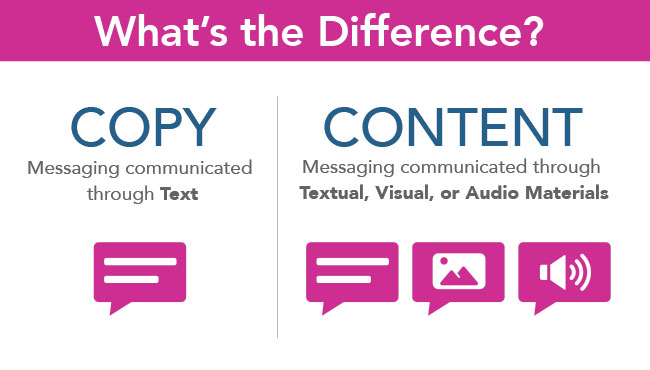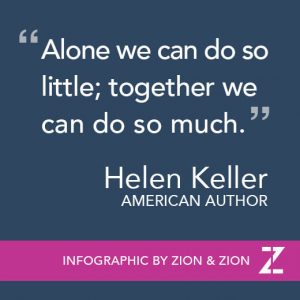If you’ve ever read an article on content marketing or held a discussion about the web, it’s likely that you’ve heard the terms “copy” and “content” thrown around interchangeably. And while you think there may be a difference between the two, it’s even more likely you’re unsure as to what that difference actually is.
As a full service agency, we addressed this topic of concern and confusion by differentiating the two terms as:
- Copy—messaging communicated through text.
- Content—messaging communicated through textual, visual, or audio materials.

While some content strategists and copywriters conclude this topic is subjective, we find that distinguishing a difference between the two industry terms increases productivity and promotes /effective communication—which is highly valuable in a full-service agency.
If your curiosity has spiked after reading the two definitions above (and we hope it has), then read on. I go more in-depth on the differences between copy and content, and why understanding their meanings is essential to productivity and seamless communication.
What is Copy?
To keep it simple, we refer to copy as: text.
By “text,” we mean words on a webpage, taglines on print ads, scripts for radio spots, etc. Copy can be written for a variety of mediums and genres and can guide readers to achieve several different actions or objectives.
Our team of content developers and copywriters, including myself, perceives copy as one piece of the content puzzle. If your goal is to increase subscribers or provide useful information for your readers to enjoy, the purpose of your copy will differ.
Copy, if done well, will:
- Sell a product
- Tell a story
- Provide insight
- Solve a problem
- Give instructions
What is Content?
All copy is considered a form of content, but not all content is copy. Think of content as all of the “contents” that make up your marketing materials—text, images, videos, and audio.
Your familiarity with the term “content” may typically be associated with the web. However, if content includes text and photos, shouldn’t print materials be considered a part of content too? The team at Zion & Zion thinks so.
Content can be classified as:
- Videos
- Fact sheets
- Infographics
- Copy
- Data
- Graphics
- Photography
- And more…
As a Content Developer at Zion & Zion, my job requirements range from writing blogs, conceptualizing infographics, writing scripts, crafting headlines, providing guidance on how videos should be edited, and more. Taking part in so many different tasks makes classifying text as either “copy” or “content” unrealistic. The true answer is that copy is content—but often just a piece of it.
Why You (And Your Company) Should Know the Difference
Acknowledging the difference between copy and content within your company helps to:
- Strengthen communication
- Solidify a content strategy
Strengthen communication
Strong communication is essential to the success of any company. At our full-service agency, we continually work towards strengthening our communication—whether we’re speaking to each other, clients, or vendors.
A task as simple as defining terminology between departments—such as the difference between copy and content—can help a team or organization avoid costly mistakes related to someone relaying a message, setting an expectation, or even assigning a task.
Handling last minute changes, confusion, and tight deadlines in the workplace are matters that concern everyone, so ensure your organization is functioning effectively by keeping communication channels strong. In the end, clarity is key. And let’s face it, developing your communication skills, whether in your professional or social life, should be at the top of your list.
Solidify a content strategy
If you’re like me, you’re always looking for methods to help further polish your content strategy. The good news is, by drawing a distinction between copy and content, you’re well on your way to understanding the importance of content.
You should never think of content as only words on a page again. Since the meaning of content includes everything from videos to social media posts, your content strategy should have both written and visual content in order for a brand to achieve its overall goal(s).
The challenge is determining and developing the best types of content your company can use to educate and engage with your audience. There are various methods to creating a well-rounded content strategy, and by doing so, you’ll successfully educate, excite, and guide users through the conversion funnel.
Do You Refer to Copy and Content Differently?
Let’s recap. For our own internal processes, and to increase productivity and promote effective communication, our team of content developers and copywriters at Zion & Zion define the following terms as:
- Copy—messaging communicated through text.
- Content—messaging communicated through textual, visual, or audio materials.
Now it’s your turn.
How do you define these terms?
If your company hasn’t distinguished a difference yet, now is the time to start the discussion. Get a group of key decision makers together and work to finalize the differences between these, and many other, industry terms.
Your Content and Copywriting Team Should Work Together
 Compelling content does more than inform readers. When web content is supported by great copy, it can capture your audience’s attention and increase engagement. It can make your audience’s journey through your site inviting and easy, which is just what you want. When all creators of content work together, you’ll notice forms of content that are better prioritized and exceptionally well worded.
Compelling content does more than inform readers. When web content is supported by great copy, it can capture your audience’s attention and increase engagement. It can make your audience’s journey through your site inviting and easy, which is just what you want. When all creators of content work together, you’ll notice forms of content that are better prioritized and exceptionally well worded.
Don’t limit yourselves to digital copy. Bringing together your content and copywriting teams can create valuable content for various marketing materials.
If at any time you’re seeking a fresh reminder of the difference between content and copy, feel free to refer back to this article.
